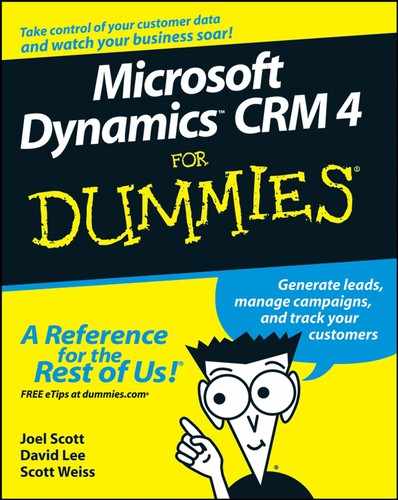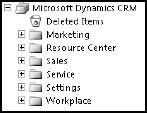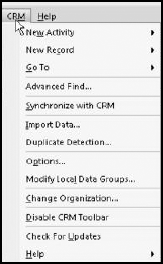Microsoft CRM is all about choices. It is very empowering, but it can also get confusing. It can be used in two ways: through the Web or through Outlook (offline or online).
In this chapter, we look at the various ways to access Microsoft CRM. Microsoft calls these clients. The three clients in which you can access Microsoft CRM are:
The online Outlook client: Access MS CRM within Outlook. The CRM data is read over the internet on the corporate server.
The offline Outlook client: Access MS CRM within Outlook without an Internet connection. When you are back online, you will automatically synchronize with the corporate server.
The Web client: Access MS CRM with Internet Explorer 6.0 and higher.
We use the Microsoft CRM Web client in the figures throughout this book. Except as described in this chapter, the other clients look and feel about the same. Most people use either the Outlook clients or the Web client, but you don't really have to make a permanent choice: You can log into one in this session and into another in your next session.
In Microsoft CRM 3, the functionality of the Outlook client was significantly less than that of the Web client. In version 4, that gap has narrowed considerably.
The Outlook client requires that you have software on your computer. This is the first difference between the Outlook client and the Web client, which requires no Microsoft Outlook 2003 / 2007, and Internet Explorer 6.0 sp1 or higher software on your computer. The significance is that when you have any client software on your computer, you need to do a small amount of maintenance. You'll need to be sure that you're on the same version of the software as that of your server. Microsoft Outlook 2003 / 2007 is part of the Microsoft Office suite and is purchased independently from CRM. MS CRM comes with integration software that enables MS Outlook to communicate with it. Before installing MS CRM Outlook software, the client must have Outlook and Internet Explorer 6.0 sp1 or higher installed.
The "online" part means that you're using Outlook online. (That is, you must have Internet access.) When you interact with Microsoft CRM using the online Outlook client, you're updating the main database directly.
One of the differences between the Outlook client and the Web client is that the Outlook client offers you the option of simultaneously updating your Outlook data when you update your CRM data.
When you open Outlook with CRM installed, you see some new items on the Outlook toolbar (Figure 2-1), in the Shortcuts pane (Figure 2-2), and in the CRM folder (Figure 2-3). As you click on these new tools, you'll see that the associated Microsoft CRM objects appear in the main Outlook screen. These Microsoft CRM objects look and work like their counterparts in the Web client and in the offline Outlook client.
The CRM Outlook software is a single application that works in two different modes: Online and Offline. Offline simply means you are caching your data locally because you have no internet connection. When you do have a connection, you will be automatically synchronized with the server. An option to go Online/Offline is an option in the toolbar.
The Microsoft CRM toolbar is a set of six horizontal icon/text combinations that appear below Outlook's normal menu and e-mail options toolbar. This custom toolbar lets you create record types and activities that coexist in Microsoft CRM and in Outlook. It includes the following tools:
CRM: This screen shows you which version of CRM you are on.
New Activity: Lets you schedule an appointment that appears in both Microsoft CRM and in Outlook. You can link the appointment to an account, contact, or opportunity in Microsoft CRM.
New Record: Lets you add a new contact record, which appears in both Microsoft CRM and in Outlook.
Track in CRM: Lets you convert selected e-mail messages into Microsoft CRM activities. In this way, you can store and view the e-mail messages on the Activities tab associated with a specific account, contact, or opportunity.
Set Regarding: Let's you set a parent record, in CRM, for the new activity created.
Advanced Find: Let's you search on multiple fields to find records.
The CRM Outlook Shortcuts contains six folders: Marketing, Resource Center, Sales, Service, Settings, and Workplace. (See Figure 2-2.)
Marketing: This folder allows you to create and manage leads, campaigns, and sales literature.
Resource Center: This folder contains information for the new user, including best practices and training material.
Sales: This folder allows you to create and manage accounts, contacts, leads, and opportunities.
Service: This folder allows you to create and manage cases and contracts. This is also where the knowledge base is configured.
Settings: This folder contains administrative tasks. Here you can manage announcements, set up users and security, configure e-mail options and rules, and configure your system settings.
Workplace: This folder allows you to create and manage your calendar, personal work items, and knowledge base, and it reports all in one area. You can also work with your accounts and contacts in this area.
The CRM menu offers the following options (see Figure 2-3):
New Activity: Lets you schedule an appointment that appears in both Microsoft CRM and in Outlook. You can link the appointment to an account, contact, or opportunity in Microsoft CRM.
New Record: Lets you add a new contact record that appears in both Microsoft CRM and in Outlook.
Go To: An option that allows you to select one of the six shortcuts: Marketing, Resource Center, Sales, Service, Settings, and Workplace.
Advanced Find: Lets you search in multiple fields to find records.
Synchronize with CRM: This option synchronizes your local data with Microsoft Outlook.
Go Online / Offline: Allows you to take your CRM data locally (Go Offline) so that you have full access to CRM functionality when disconnected from the internet. Go Online synchronizes your local data with the server database and then continues to use the server database until you go offline. This option is extremely handy if you are on the road often.
Import Data: Allows you to import records into CRM from an external file.
Duplicate Detection: Allows you to define rules that constitute duplicate records and define how to merge them together.
Options: Allows you to set your personal settings, such as default records per page, which items to synchronize (contacts, appointments, and so on), configure your Workplace, set formats (currency, time display, date display, and so on), and your base language.
Modify Local Data Groups: Allows you to create groups of records, based on field values, to synchronize with Outlook.
Change Organization: This option allows you to uninstall Outlook CRM software or re-configure it to point to a different server database. (For example, if you have the software installed but move to a different company.)
Disable Toolbar: Because most of the options listed here are accessible via the shortcuts or CRM Toolbar, you may wish to simply disable this toolbar.
Check For Updates: This option checks the Microsoft Web site for any updates to the software.
The Microsoft CRM offline Outlook client looks and works like the online Outlook client. The difference is that you're offline, so the offline client must store its data right on your laptop computer. The advantage of the offline Outlook client is that you can use your computer on airplanes, at client sites, or anywhere else where you don't have Internet access.
The disadvantage of the offline Outlook client is that the data isn't written directly to your server database. Instead, it's written to a local database that you later synchronize with the server database when you're back online. You don't see changes to the server database — and online users don't see changes to your database — until you synchronize your data.
In addition, synchronization can cause data conflicts. This isn't a Microsoft CRM problem: All synchronizing databases have data conflicts, and they all need conflict resolution rules. This all sounds very academic, so let's look at a simple example:
Suppose you're offline and you edit David Lee's telephone number to 703-367-9571. Before you synchronize, someone at the main office edits that same number to 703-367-9572. There is now a potential data conflict. Only one of you will "win."
Note
Microsoft CRM uses the following conflict resolution rule: The person who is synchronizing the data "wins." That means that changes in the laptop database overwrite changes on the server when you log back on. That also means that if you use the offline Outlook client, you should synchronize your data as soon as possible after you make changes.
When you sync from the server to your laptop, there should be no data conflicts because you presumably haven't made any changes in your offline client since the last time you went online.
Note that Microsoft CRM 4 has a new diagnostic tool that identifies records that cause problems with synchronization. See the section, "What's New in Microsoft CRM 4.0 Outlook Client," later in this chapter, for details.
As noted in the Online Outlook Client section, you launch the synchronization from the Microsoft CRM toolbar. Select the Go Offline option (assuming that you're online at the time). This lets you synchronize your current CRM data with your local computer or, if you're offline and are going online, send all changed data from your local computer to the CRM server (Go Online).
The Web client is the access method used in the examples throughout this book, so we don't go into much detail here.
With Web access, you don't need any software on your computer. You can actually access your system from the lobby or business center computer in a hotel.
You must do all setup and configuration tasks through the Web client. However, as we mentioned earlier, you can use any of the clients during any session. You don't need to make a permanent selection of which client to use.
Microsoft CRM 4 improves on version 3 by adding a number of new enhancements and features. These improvements, guided by customer evaluation, are focused on end-user benefits, support for global organizations (in the form of multi-language packs and currencies), and increased application scalability (running multiple instances of CRM 4 on the same physical machine).
Because you will not likely be working with CRM 4 in the back-end, the following enhancements are focused on regular usage of CRM.
The Diagnostic Tool: This is a standard part of the Outlook client. In Windows, navigate to Start

The Diagnostic Tool can identify records that cause problems with synchronization, and it can identify and resolve CRM add-ins that have been disabled. It can analyze your log files and report to your support desk so that your support people can provide you with better support. It can check for updates and disable your system if you don't have a mandatory update installed.
User interface enhancements: These enhancements include the following:
Promote up to 20 contact or appointment records at a time from Outlook to Microsoft CRM. This saves time by allowing the end-user to highlight 20 contacts in Outlook and click on a single button to send them to MS CRM.
Synchronize tasks (available in version 3) as well as telephone calls, letters, and faxes (all new in version 4).
Set the Regarding feature for e-mail messages. (This links the e-mail from Outlook to the parent account in MS CRM.)
You do this by clicking Track in CRM on the toolbar. After saving the record, click View in CRM. If you're using Outlook 2003, click Regarding. If you're using Outlook 2007, click Set Parent or Set Regarding. Then click Save and Close.
In Microsoft CRM 4, you can enter data into Outlook or into the CRM windows, which means that you can now enter data into a custom CRM data field.
Auto Resolution for lookup fields: When you're searching for a value, you can get a list of all records meeting your search criteria.
Converting activities: Convert an activity to an opportunity (available in 3.0) or to a lead, an opportunity, or a case. On the Actions toolbar, click Convert Activity and then select from the options.
Mail merge: In version 3, mail merge worked only from the Outlook client. In 4, it works from the Web client as well.
Reporting services enhancements: These enhancements include the following:
Report Wizard: This allows you to create reports using an easy to follow graphical display on demand. (In version 3, it was not possible to create reports within CRM.) This Report wizard allows you to group data; summarize data (totals and subtotals); present data in tables, graphs, and charts; and print without exporting to Excel.
Export to Excel: This was available in version 3. The new features include exporting data from related entities and editing queries after you create your spreadsheet.
Offline synchronization improvements: These improvements include the following:
Background synchronization: Instead of clicking Go Offline and waiting while synchronization runs, you can synchronize continuously in the background. (Note that this puts an extra load on your server.)
You can set this by doing the following: From the Outlook client on the CRM menu, click Options, then click the Synchronization tab, and select Synchronize Local Data Every X Minutes. It defaults to every 15 minutes. The smaller you make the time interval, the greater the extra load on your server.
Changes to default synchronization settings: These are intended to reduce the load on the server. You can still change the settings if you like.
Contacts aren't synchronized: These include only your Outlook clients, not all of the contacts in Microsoft CRM.
Only records owned by the user are synchronized.
Address book synchronizes every 24 hours: You can change this by clicking Set Personal Options and then Synchronization. From the resulting screen you can change all of your sync settings.


